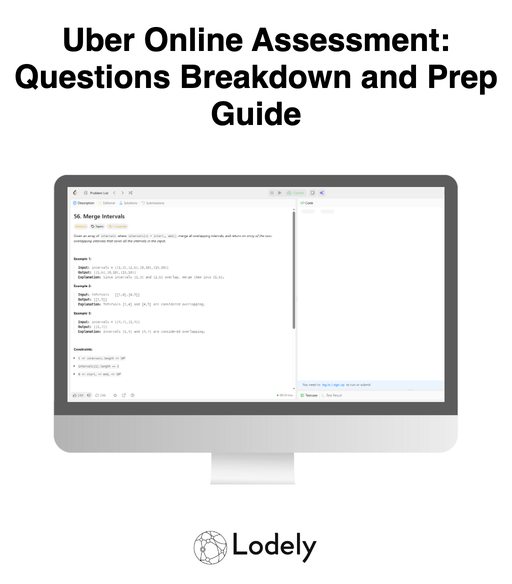Uber Online Assessment: Questions Breakdown and Prep Guide
Thinking about “Cracking Uber’s Assessment” but not sure what you’re getting into? You’re not alone. Engineers face HackerRank, CodeSignal, real-time pressure, and marketplace-style puzzles — and the hardest part is knowing which challenges to train for.
If you want to walk into the Uber Online Assessment (OA) confident, prepared, and ready to knock it out of the park, this guide is your playbook. No fluff. Real breakdowns. Strategic prep.
When to Expect the OA for Your Role
Uber’s OA varies by role, level, and team. Here’s the usual pattern:
- New Grad & Intern Positions – Almost every candidate gets an OA shortly after recruiter outreach. For internships, it’s often the primary technical screen.
- Software Engineer (Backend / Full-Stack / Platform) – Expect a timed assessment link via HackerRank or CodeSignal. Questions skew toward arrays, hashing, graphs, and heap/interval problems tied to dispatch and routing.
- Mobile (Android / iOS) – A standard coding OA first (DS&A). Some teams follow with a platform-specific take-home or UI/architecture deep-dive.
- Maps / Routing / Marketplace / Infrastructure – You’ll still get DS&A, but expect graph shortest path, interval scheduling, and heap-based matching or rate-limiting scenarios.
- Data Engineering – OA can include algorithmic coding plus SQL/ETL-style transformations and log processing.
- Senior Engineering Roles – Some teams skip a generic OA and move straight to live coding and system design, but many still use an OA as the first filter.
Action step: When the recruiter reaches out, ask for the platform, the number of questions, and the time limit. Many Uber OAs are 90 minutes for 2–3 questions; CodeSignal variants can be ~70 minutes for 4 tasks.
Does Your Online Assessment Matter?
Short answer: yes — it’s a strong signal and often the main gate.
- It’s the primary filter. A strong resume earns the invite; your OA determines if you proceed.
- It’s referenced later. Interviewers may peek at your OA code to tailor follow-ups.
- It reflects the domain. Uber leans into marketplace/dispatch patterns: intervals, heaps, graphs, and real-time constraints.
- It signals engineering hygiene. They look at correctness, edge-case handling, complexity, and how readable/maintainable your code is.
Pro Tip: Treat the OA like a first interview. Write clean code, name variables clearly, and include quick sanity checks or helper tests if the platform allows.
Compiled List of Uber OA Question Types
Candidates report seeing these categories. Practice them:
- Car Fleet — type: Sorting / Greedy
- Meeting Rooms II — type: Intervals / Min-Heap
- Network Delay Time — type: Graph / Dijkstra
- Minimum Time to Arrive on Time — type: Binary Search on Answer
- K Closest Points to Origin — type: Heap / Geometry-lite
- Merge Intervals — type: Intervals / Sorting
- Sliding Window Maximum — type: Deque / Sliding Window
- Top K Frequent Elements — type: Heap / Hashing
- LRU Cache — type: Design / HashMap + Doubly Linked List
- Course Schedule — type: Graph / Cycle Detection
- Task Scheduler — type: Greedy / Heap
- Design Rate Limiter / Hit Counter — type: Queue / Sliding Window
- Split Array Largest Sum — type: Binary Search / Greedy
- Reorganize String — type: Heap / Greedy
- Distant Barcodes — type: Heap / Arrangement
How to Prepare and Pass the Uber Online Assessment
Think of your prep like a mini training camp. You’re building reflexes, not memorizing scripts.
1. Assess Your Starting Point (Week 1)
List what you’re strong in (arrays, hashing, strings) and what you avoid (graphs, intervals, binary search on answer). Use LeetCode Explore or CodeSignal practice sets to baseline your speed and accuracy. This tells you what to double down on.
2. Pick a Structured Learning Path (Weeks 2-6)
You have options:
- Self-study on LeetCode/HackerRank
- Best for disciplined learners; you control pacing and topic depth.
- Timed mock OAs or paid simulators
- Mimic CodeSignal/HackerRank constraints and scoring; great for pacing.
- Career coach or mentor
- A software engineer career coach can critique code clarity, complexity trade-offs, and communication.
3. Practice With Realistic Problems (Weeks 3-8)
Build a list of 40–60 problems centered on: intervals + heaps, graphs + Dijkstra, sliding windows, binary search on answer, and basic data structure design (LRU, rate limiter). Solve under a timer. After each session, refactor for readability and edge cases.
4. Learn Uber-Specific Patterns
Uber’s domain often maps to these patterns:
- Marketplace matching & ETA
- Intervals + min-heaps for “next available driver,” top-k search for nearest supply.
- Routing & traffic
- Graph shortest paths (Dijkstra/priority queue), handling blocked edges or dynamic weights.
- Demand surges & windows
- Sliding window/deque for moving averages and max-in-window computations.
- Rate limiting & reliability
- Sliding windows, counters, and bucketing; consider time complexity and memory pressure.
- Numeric accuracy
- Prices/tips/fees: prefer integer cents to avoid floating-point surprises; handle rounding rules.
5. Simulate the OA Environment
Use the platform you expect (HackerRank or CodeSignal). Turn off distractions. Set the exact time limit (often 90 minutes for 2–3 problems; some CodeSignal rounds are ~70 minutes for 4). Practice reading prompts fast, identifying the core pattern, and implementing with tests.
6. Get Feedback and Iterate
Review your solutions the next day. Track repeat mistakes (off-by-ones in intervals, missing disconnected nodes in graphs, heap misuse). Share with a peer or mentor. Re-solve misses without looking at your past code until you can do it cleanly.
Uber Interview Question Breakdown

Here are featured sample problems inspired by Uber’s OA patterns. Master these and you’ll cover most bases.
1. Driver–Rider Matching Within Time Windows
- Type: Intervals / Min-Heap
- Prompt: Given rider requests with start times and durations, and a fixed number of drivers, compute the minimum average wait time by assigning drivers to requests. Each driver is busy until their assigned request’s end time.
- Trick: Sort requests by start time; keep a min-heap of driver availability (earliest end time). Assign the earliest-available driver; wait time is max(0, driver_free_time − request_start).
- What It Tests: Interval reasoning, heap mastery, and turning scheduling heuristics into code under time pressure.
2. Shortest Path With Traffic and Road Closures
- Type: Graph / Dijkstra
- Prompt: Given a directed road network with travel times and a list of closed edges, compute the shortest time from a source to all nodes (or to a destination).
- Trick: Pre-filter closed edges or skip them during relaxation. Use a priority queue; don’t use BFS on weighted graphs.
- What It Tests: Priority queues, robust graph modeling, and handling edge cases like unreachable nodes.
3. Surge Window Maximum Demand
- Type: Sliding Window / Deque
- Prompt: Given an array of ride requests per minute and a window size w, find the maximum total demand over any contiguous w-minute window.
- Trick: Use a prefix sum for O(1) window sums, or maintain a running sum; if asked for max per-minute within windows, use a deque for O(n) sliding maxima.
- What It Tests: Window math, off-by-one hygiene, and optimizing past brute force.
4. K Nearest Drivers to a Pickup
- Type: Heap / Geometry-lite
- Prompt: Given driver coordinates and a pickup location, return the k nearest drivers by Euclidean distance (approximate great-circle if allowed).
- Trick: Use a max-heap of size k storing squared distances to avoid sqrt; for large inputs, stream with heap pruning.
- What It Tests: Top-k patterns, numerical care, and space/time trade-offs.
5. Precise Fare Split and Rounding
- Type: Math / Implementation
- Prompt: Split a fare among n riders with service fees and taxes, applying round-half-up to cents while ensuring the sum of parts equals the total.
- Trick: Convert to integer cents; compute each share; distribute rounding remainders starting with the largest fractional parts to keep totals consistent.
- What It Tests: Implementation rigor, integer arithmetic to avoid floating-point error, and correctness under edge cases.
What Comes After the Online Assessment

Clearing the OA gets you into the real conversation — problem-solving, systems thinking, and team fit. Here’s what usually follows.
1. Recruiter Debrief & Scheduling
If you pass, expect an email within a few days. You’ll hear about your next steps, timelines, and the structure of the onsite or virtual loop. Ask what competencies each round targets so you can tailor your prep.
2. Live Technical Interviews
Expect 1–2 coding sessions on a shared editor or video call:
- DS&A questions similar to the OA, but interactive
- Reason-aloud debugging (“Why is this failing on edge cases?”)
- Communication and trade-offs as you code
Pro tip: Review your OA submissions; interviewers often ask you to walk through them.
3. System Design / Architecture Round
For mid-level and senior roles, you’ll get a design session. Typical prompts:
- Design an ETA service for trips across a city
- Build a surge pricing service based on real-time demand
- Architect a dispatch/matching engine between riders and drivers
They’re probing:
- How you reason about scale, consistency, and failure modes
- Data modeling for geospatial or time-series workloads
- Sensible use of caches, queues, and rate limiting
4. Mobile or Platform-Specific Deep Dives
Role-dependent follow-ups may include:
- Android/iOS architecture, offline caching, and UI responsiveness
- Backend concurrency, API design, and observability
- Maps/routing: graph updates, data freshness, and latency budgets
5. Behavioral & Values Interviews
Uber emphasizes ownership, customer obsession, and safety. Expect prompts like:
- “Tell me about a time you shipped under uncertainty.”
- “Describe a high-severity incident and your role in resolving it.”
- “When did you disagree with a product direction? What happened?”
Use the STAR method (Situation, Task, Action, Result). Highlight bias for action, data-driven decisions, and cross-team collaboration.
6. Final Round / Onsite Loop and Offer
The final loop typically bundles:
- Another coding round
- A design or architecture session
- Cross-functional conversations (product, data, or infra) If successful, you’ll get a verbal followed by a written offer. Compensation often includes base, bonus, and equity. Research market bands and be prepared to negotiate.
Conclusion
You don’t need to guess. You need a plan. The Uber OA is demanding but predictable. If you:
- Identify weak areas early,
- Drill Uber-style patterns (intervals + heaps, graphs, sliding windows, binary search on answer),
- Practice under timed conditions and write clean, edge-proof code,
you’ll turn the OA from a blocker into your springboard. Marketplace context helps, but disciplined problem solving wins. Treat the OA like your first interview — because it is.
For more practical insights and prep strategies, explore the Lodely Blog or start from Lodely’s homepage to find guides and career resources tailored to software engineers.






%2C%20Color%3DOriginal.png)



